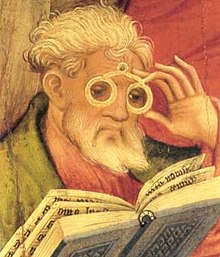
Modern glasses are typically supported by pads on the bridge of the nose and by temple arms (sides) placed over the ears. CR-39 lenses are the most common plastic lenses due to their low weight, high scratch resistance, low dispersion, and low transparency to ultraviolet and infrared radiation.[citation needed] Polycarbonate and Trivex lenses are the lightest and most shatter-resistant, making them the best for impact protection.[1]
An unpopular aspect of glasses is their inconvenience. Though modern frames can be both lightweight and flexible, and new lens materials and optical coatings are resistant to breakage or scratching, glasses can still cause problems during rigorous sports. Visibility can be significantly reduced by becoming greasy, trapping vapour when eating hot food, swimming, walking in rain or rapid temperature changes (such as walking into a warm building from cold temperatures outside). Scraping, fracturing, or breakage of the lenses require time-consuming and costly professional repair.
Invention of eyeglasses
The first eyeglasses were made in Italy at about 1286, according to a sermon delivered on February 23, 1306
The American scientist Benjamin Franklin, who suffered from both myopia and presbyopia, invented bifocals.

Woman wearing designer sunglasses.






